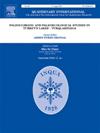Late Quaternary alluvial fan stratigraphy and chronology, Elqui, Turbio and Claro valleys, semiarid Andes of Chile
IF 1.8
3区 地球科学
Q3 GEOGRAPHY, PHYSICAL
引用次数: 0
Abstract
New mapping and luminescence geochronology of tributary alluvial fan deposits from the semiarid Subtropical Andes of Chile are used to infer Late Pleistocene–Holocene paleoclimate conditions for the region. During this period, alluvial fans descending from tributary catchments to major river valleys encroached on fluvial deposits, creating a record of interbedded fluvial-alluvial deposition, and in places, generated extensive river damming. The oldest sequence of fan deposition (∼40 ka) appears eroded and disconnected from active channel deposition. Other regionally distributed fan sequences are dated to 14–11 ka, ∼8 ka, and 3–1 ka. Common depositional timing of the thick 14–11 ka fans in catchments sourced from high and intermediate elevations suggests a common factor in generating these fans, possibly linked to a regional precipitation increase derived from Pacific moisture sources in the context of a gradual temperature rise since the local last glacial maximum. A short duration fan sequence occurred centered at ∼8 ka in some outlets sourced from high-elevation catchments. The occurrence of the 8 ka fans during the most arid period of the Holocene in the subtropical Andes suggests an easterly moisture source for the precipitation events that generated the fans, that could be associated with an effect of the 8.2 ka event (Bond event 5) leaking into the Southern Hemisphere. A minor Late Holocene aggradation period is linked to a regional humid period with westerlies as the principal moisture source and an increase in ENSO-warm signal frequency and intensity as a driver. Fan aggradation occurs during periods with both ascent and descent of the major regional vegetation ecotones. This observation suggests that, in this setting, hillslope hydrology and rainfall style control aggradation periods rather than vegetation change.
智利半干旱安第斯山脉Elqui、Turbio和Claro山谷晚第四纪冲积扇地层和年代学
利用智利半干旱亚热带安第斯山脉支流冲积扇沉积的新填图和发光地质年代学,推断该地区晚更新世-全新世古气候条件。在此期间,冲积扇从支流集水区降至主要河谷,侵蚀河流沉积物,创造了河流-冲积互层沉积的记录,并在某些地方产生了广泛的河流筑坝。最古老的扇沉积层序(~ 40 ka)似乎被侵蚀并与活动水道沉积分离。其他区域分布的扇层序年代为14-11 ka、~ 8 ka和3-1 ka。来自高海拔和中海拔的集水区14-11 ka厚扇的共同沉积时间表明,这些扇的形成有一个共同的因素,可能与自当地末次极大期以来温度逐渐升高的背景下太平洋水汽源引起的区域降水增加有关。在一些来自高海拔集水区的出口中,出现了以~ 8 ka为中心的短持续期扇序列。在全新世亚热带安第斯山脉最干旱的时期,8 ka扇的出现表明,产生扇的降水事件的水汽来源可能与8.2 ka事件(Bond事件5)泄漏到南半球的影响有关。一个较小的晚全新世沉积期与以西风带为主要水汽源和enso暖信号频率和强度增加为驱动因素的区域性湿润期有关。扇积作用发生在主要区域植被带上升和下降的时期。这一观察结果表明,在这种情况下,坡面水文和降雨方式控制的是沉积期,而不是植被变化。
本文章由计算机程序翻译,如有差异,请以英文原文为准。
求助全文
约1分钟内获得全文
求助全文
来源期刊

Quaternary International
地学-地球科学综合
CiteScore
5.60
自引率
4.50%
发文量
336
审稿时长
3 months
期刊介绍:
Quaternary International is the official journal of the International Union for Quaternary Research. The objectives are to publish a high quality scientific journal under the auspices of the premier Quaternary association that reflects the interdisciplinary nature of INQUA and records recent advances in Quaternary science that appeal to a wide audience.
This series will encompass all the full spectrum of the physical and natural sciences that are commonly employed in solving Quaternary problems. The policy is to publish peer refereed collected research papers from symposia, workshops and meetings sponsored by INQUA. In addition, other organizations may request publication of their collected works pertaining to the Quaternary.
 求助内容:
求助内容: 应助结果提醒方式:
应助结果提醒方式:


